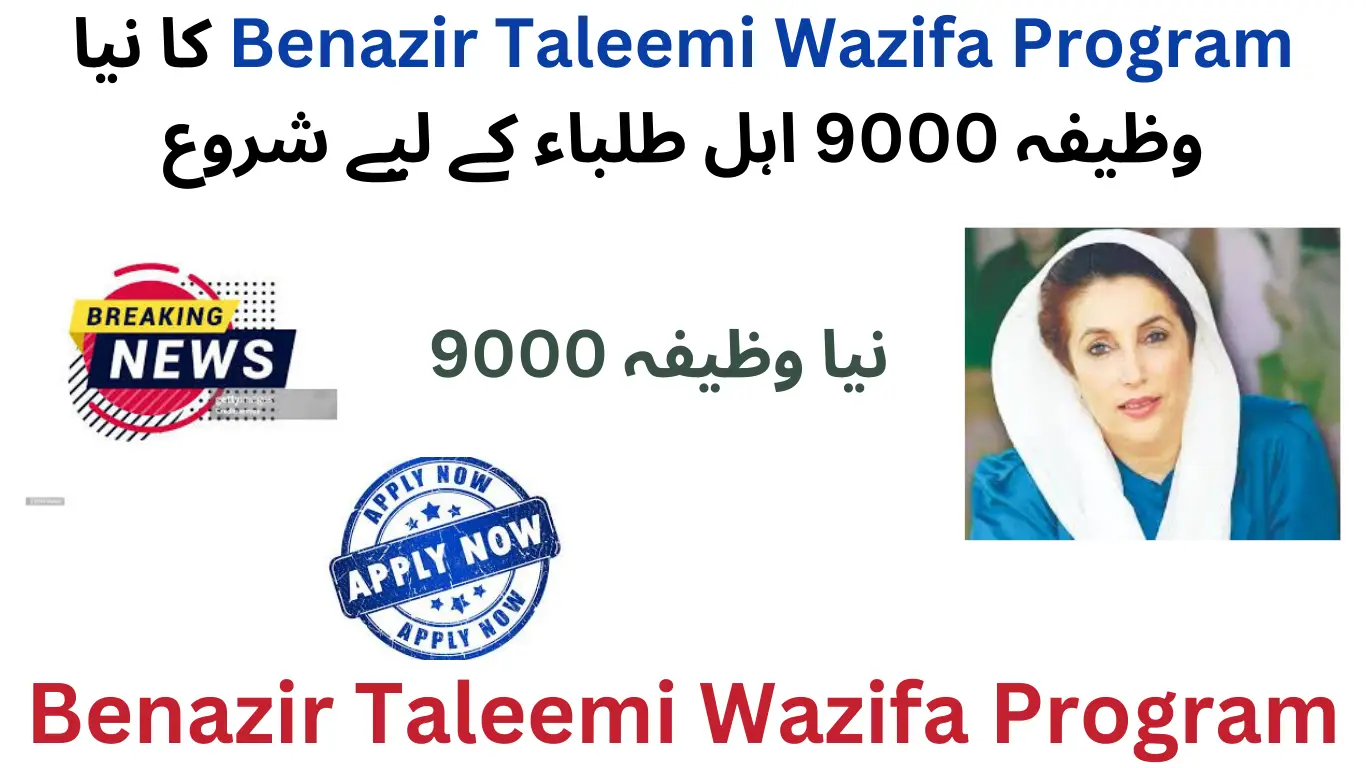The Benazir Taleemi Wazaif Program is a key initiative by the Government of Pakistan to support the education of underprivileged children. This program is part of the more extensive Benazir Income Support Programme (BISP). It seeks to reduce dropout rates, encourage enrollment, and promote quality education among students from low-income families. The announcement of a new 9,000 PKR stipend for eligible students is a significant step toward providing better educational opportunities to those most in need.
In this article, we will explore the details of the Benazir Taleemi Wazaif Program, discuss the eligibility criteria for the new stipend, and guide you through the application process. Additionally, we will address some frequently asked questions (FAQs) to help you understand the program better.
Benazir Taleemi Wazaif Program 2024
The Benazir Taleemi Wazaif Program was launched to ensure that children from economically disadvantaged backgrounds can access education. The program provides financial support to families to cover educational expenses, reducing the financial burden that often forces children to drop out of school. The program focuses on both boys and girls, with a particular emphasis on promoting female education.
Also Read” Ehsaas Kafaalat Double Payment of 25,000 PKR Started
Benazir Taleemi Wazaif Program New 9,000 PKR Stipend
The new 9,000 PKR stipend under the Benazir Taleemi Wazaif Program is a one-time payment designed to support eligible students in meeting their educational needs. This stipend is part of the government’s broader effort to provide additional financial assistance to students from low-income families, particularly in light of rising educational costs.
Eligibility Criteria
To qualify for the new 9,000 PKR stipend under the Benazir Taleemi Wazaif Program, applicants must meet the following criteria:
- Enrollment in School: The student must be enrolled in a public or registered private school.
- Low-Income Household: The applicant must belong to a low-income household, as determined by the government’s poverty scorecard or through their existing BISP registration.
- Regular Attendance: The student must maintain regular attendance in school, as the program is designed to encourage consistent education.
- Age Requirement: The program typically targets students between 5 and 18.
- BISP Beneficiary: The family must already be a beneficiary of the Benazir Income Support Programme to be eligible for the Taleemi Wazaif stipend.
How do I apply for the Benazir Taleemi Wazaif Program?
If you believe your child is eligible for the new 9,000 PKR stipend, you can follow these steps to apply:
- Visit the Nearest BISP Office: The first step is to visit the nearest BISP office or an Ehsaas Center to inquire about the Taleemi Wazaif program.
- Verify Eligibility: You can verify your eligibility for the stipend at the office. You may need to provide documents such as your CNIC, proof of income, and the child’s school enrollment certificate.
- Fill Out the Application Form: If eligible, you will be given an application form to fill out. Make sure to provide accurate details about your child’s school, class, and attendance.
- Please submit the Application: After completing the form, submit it with the required documents. The application will be processed, and you will be notified about its status.
- Receive the Stipend: If your application is approved, you will receive the 9,000 PKR stipend through the payment method you registered with BISP, typically via mobile banking or direct bank transfer.
Conclusion
The Benazir Taleemi Wazaif Program’s new 9,000 PKR stipend is a crucial initiative to support the education of children from low-income families in Pakistan. By understanding the eligibility criteria and following the application process, you can ensure that your child benefits from this government program. For further information or assistance, visit the nearest BISP office or refer to the FAQs in this article.
Frequently Asked Questions (FAQs)
Q1: What is the Benazir Taleemi Wazaif Program?
The Benazir Taleemi Wazaif Program is an initiative under the Benazir Income Support Programme (BISP) that provides financial assistance to low-income families to support their children’s education.
Q2: Who is eligible for the 9,000 PKR stipend?
Eligibility for the 9,000 PKR stipend requires that the student be enrolled in school, belong to a low-income household, maintain regular attendance, and be part of a family already benefiting from BISP.
Q3: How can I apply for the stipend?
You can apply for the stipend by visiting the nearest BISP office or Ehsaas Center, verifying your eligibility, filling out the application form, and submitting the required documents.
Q4: What documents do I need to apply?
You must provide your CNIC, proof of income, and the child’s school enrollment certificate, among other documents specified by the program.
Q5: How will I receive the stipend?
If your application is approved, the stipend will be disbursed through mobile banking or direct bank transfer, depending on your registered payment method with BISP.
Q6: Can I apply if my child is enrolled in a private school?
You can apply for the stipend if the private school is registered and your family meets the other eligibility criteria.
Q7: What should I do if I do not receive the stipend after approval?
If you do not receive the stipend despite approval, you should contact your nearest BISP office or Ehsaas Center to resolve the issue.

[…] The Sindh Solar Panel Scheme is a government initiative launched to promote the use of renewable energy in the province of Sindh. This scheme aims to provide affordable and sustainable solar energy solutions to households, especially in rural and underserved areas. In August 2024, the government announced the start of registration for the scheme, inviting eligible families to apply and take advantage of this opportunity to reduce their electricity bills and contribute to a greener environment. […]
[…] Incentive: The government provides a subsidy of 50,000, making solar panel installation more affordable for […]